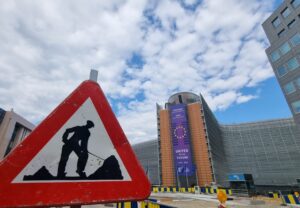
Mathias Corvinus Collegium is launching educational programs for high schoolers and fifth graders in Dunajská Streda, Slovakia.Continue reading

Is Europe’s cultural soul being quietly erased? This explosive report by the Hungarian-funded thinktank, MCC Brussels, exposes how the European Union is strategically co-opting culture to advance a radical social and political agenda. Its author, Dr. Katalin Deme uncovers how Brussels manipulates language, redefines heritage, and channels billions through programs like Creative Europe to promote its vision of a post-national society.
Drawing unsettling parallels with the linguistic tactics of totalitarian regimes, the report argues that the EU’s focus on “diversity,” “inclusion,” and “intercultural dialogue” comes at the cost of Europe’s foundational traditions, unique cultural values, and even basic concepts of language. It examines how the New European Agenda for Culture and the Creative Europe funding program are prioritizing themes like migration, gender ideology, and environmentalism, overshadowing and even undermining Europe’s Judeo-Christian and Enlightenment heritage.
This report explores the dystopian jargon emerging from EU-funded projects, where concepts like “cultural ecosystems” and the “de-elitisation of culture” serve a broader political purpose. Terms like “nation” are seemingly avoided, while buzzwords associated with a specific ideological viewpoint are promoted.
However well-intentioned, are these initiatives be masking a systematic erosion of European cultural identity, leading to a dangerous state of “cultural nihilism”? This report dares to ask whether the EU’s pursuit of “unity in diversity” has morphed into a project of cultural transformation that could ultimately erase Europe’s true self.
In its conclusion the report highlights that in 2024, the Creative Europe program celebrated its 10-year anniversary. This decade has changed Europe almost beyond recognition. The liberalization processes of the 1960s were completed on the scale of a nightmare.
Fundamental cultural taboos were broken, traditional family and gender models were suspended, and the historical roots and cultural identity of Europe were called into question.
All this was done not only through stealthy legislation, psychological intimidation and censorship reaching into our most private thoughts, but also via the transformation of our language and the meaning of our words.
Since 2014, Creative Europe has been supporting projects that, ‘promote cultural diversity, support artistic expression and boost the economic potential of the creative industries. Pushing boundaries is about finding new ways of artistic expression, how you redefine creating a work of art. Challenging boundaries is to challenge ourselves every day.’
Pushing the boundaries in this case means openly supporting LGBTQ+ and gender-inclusive projects, same-sex family models and different modes of progressive self-empowerment that conflict with established norms rooted in Christianity, national traditions and intergenerational bonds. An open critique of the program’s ideological agenda is difficult, as its goals are legitimized behind the ‘bulletproof ’ slogans of inclusion, solidarity, democracy, pluralism and media freedom. Occasional criticism of Creative Europe includes articles in the British tabloids. However, when seeing the irreversible cultural dissociation of Englishness and Britishness, even after Brexit, such criticism seems more like a political backlash against the EU than a genuine introspection into the fatal consequences of such spending.
But the problem is deeper than the inherently ambivalent focus areas of the program. The true danger is that they consequently target the truly diverse European culture and way of life, which are nonetheless rooted in Judeo-Christian civilization and the Enlightenment.
Diminishing or abolishing this heritage cuts our ties to Europe’s cultural foundations and transforms the EU to a fading historical stage.
Linguistic patterns found in selected project descriptions warn of the worst. They show an astonishing decline in sophisticated language use, manifested through a long range of examples of infantile project ideas bordering on idiocy, a cacophony of culturally non-related terminology borrowed from the economic and political fields, and Dadaist neologisms that make no sense whatsoever.

Photo: Hungary Today
Indeed, the falsification and misuse of language, the use of euphemisms to hide controversial or dehumanizing agendas, is an inherent feature of political power. However,
the EU’s linguistic conquest is paradoxically directed against its own past and thus its member states’ unique cultural heritage, handed down through generations.
Moreover, the EU’s jargon does not, like the Orwellian newspeak, reduce the richness of language to its rudimentary structure. On the contrary, it artificially extends the semantic contexts and grammatical connectivity of language until its message loses its original meaning or its meaning per se.
The concept of nation at large is replaced by the concept of community or people. Christianity appears in the projects as a distant realm belonging to the fields of archaeological excavations. European populations can be, at worst, identified as a white, heterosexual, racist and Islamophobic species. The quest for excellence and beauty, which are the fundamentals of Western cultural heritage, are strikingly missing from the cultural project descriptions.
Jean Monnet, founding father of the European Union, allegedly said that if he could rethink the European idea, he would start with culture. What Monnet might have meant by that is that in the 1970s, European culture still adhered to strong national reference frames. Half a century later, Monnet’s vision of a supranational European State is almost accomplished, yet at the same time Europe ceases to be a single and unique civilization. Another 10 years of the Creative Europe program and cultural nihilism will succeed.
About the author
Katalin Deme is responsible for expanding MCC Brussel’s academic network and promoting events in the fields of history, memory culture and the arts. A native of the Hungarian minority in Slovakia, she is one of the founders of the first Slovak Jewish museums in Presov and Bratislava.
You can read the full report HERE.
Featured Image: Hungary Today